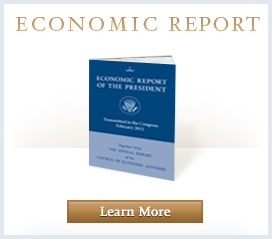Strengthening the Rural Economy - Executive Summary
STRENGTHENING THE RURAL ECONOMY
EXECUTIVE SUMMARY
Rural areas are home to about 50 million Americans and are an essential part of the overall economy. This report surveys the current state of rural America and describes the Obama Administration’s policies for strengthening the rural economy. Many of these policies are already being implemented through the American Recovery and Reinvestment Act of 2009. But further work remains to ensure the prosperity and vitality of rural America.
The Current State of Rural America
Our survey of the current state of rural America identifies both important strengths and significant challenges facing the rural economy.
- The rural economy is more economically diverse than it once was. Agriculture directly employs only a small fraction of rural workers, though ancillary businesses are included in other sectors. Manufacturing, services, government, and wholesale and retail trade are important additional sources of rural employment.
- The U.S. agricultural sector remains more productive than those of other high-income countries and is highly competitive in international markets.
- The labor force of rural America is aging and its educational attainment lags behind that of urban areas for the working-age population.
- Improvements in health status in rural areas have not kept pace with those in urban areas, and access to doctors and health services has been an important challenge in rural areas.
Growing New Businesses in Rural Areas
One key category of Administration policies for strengthening rural America is focused on growing businesses and expanding employment opportunities.
- The Recovery Act greatly increased support for small business lending through the Small Business Administration (SBA). The dollar value of SBA loans to rural areas was 2.5 times higher in December 2009 than in January 2009.
- Steps to promote clean energy are likely to have a particularly important impact on rural areas by increasing the demand for biofuels and encouraging renewable energy generation.
- The Recovery Act is investing $2.3 billion to preserve and improve the quality and accessibility of Federal lands. By doing so, it is creating important new opportunities for rural tourism and recreation.
Strengthening Rural Infrastructure
Another category of Administration policies is focused on continuing essential investments in rural infrastructure. Such investments create jobs today and improve the productivity of the rural economy in the future.
- Through the Recovery Act and other initiatives, the Administration is investing heavily in accelerating the spread of broadband internet service to rural areas.
- The Recovery Act provides funds to upgrade and improve the efficiency of existing water infrastructure. It also includes $3.7 billion in loans and grants for rural water and wastewater infrastructure aimed at addressing the lack of safe drinking water in some rural areas.
Improving America’s Support of Agriculture
A third category of policies seeks to improve Federal support for agriculture. By doing so, these policies aim to strengthen this key sector of the rural economy.
- As part of the Administration’s National Export Initiative, the President has called for further measures to open foreign markets to agricultural goods.
- The President’s 2011 budget calls for a number of reforms to existing farm support programs, including tighter eligibility requirements to preclude the wealthiest farmers from receiving payments and changes to the crop insurance program to reduce windfall profits.
- Initiatives such as the Know Your Farmer, Know Your Food program promote the development of local and regional food systems that deliver fresh food to consumers who live in close proximity to farms.
Investing in the Education and Health of Rural Communities
Through the Recovery Act and other legislation, the Federal government is making key investments in rural education and health care to reduce disparities between rural and urban areas.
- The State Fiscal Stabilization Fund in the Recovery Act is providing $7 billion for education in rural communities as a down payment on the President’s broader goal of creating a more educated rural workforce.
- The President’s American Graduation Initiative, together with infrastructure investments in rural broadband, will help make high-quality online courses available, especially benefiting rural areas.
- The Recovery Act invests nearly $26 billion in health information technology, which is likely to be particularly valuable in dealing with the unique difficulties rural residents face in accessing doctors and hospitals.
- In addition to the benefits provided to all Americans, health insurance reform through the Patient Protection and Affordable Care Act provides special support for the rural medical workforce by expanding graduate medical education positions in rural teaching hospitals and by supporting training for doctors and nurses in rural health care.
Contents
I. INTRODUCTION
II. THE CURRENT STATE OF RURAL AMERICA
III. GROWING NEW BUSINESSES IN RURAL AMERICA
IV. STRENGTHENING RURAL INFRASTRUCTURE
V. IMPROVING AMERICA'S SUPPORT OF AGRICULTURE
VI. INVESTING IN THE EDUCTATION AND HEALTH OF RURAL COMMUNITIES
VII. CONCLUSION


